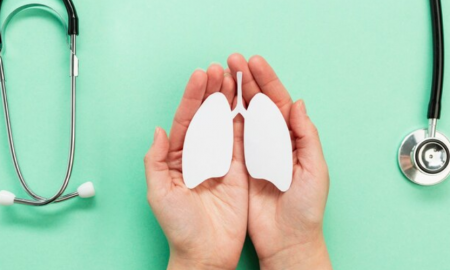
Here’s What You Can Do To Self-Examine For Potential Signs Of Skin Cancer!

Skin cancer is the most common form of cancer in the United States and affects millions of people each year. While it is highly treatable if caught early enough, the best approach to fighting skin cancer is prevention.
One way to do this is to regularly self-examine your body for changes that could indicate skin cancer. Knowing what to look for and how to do a proper self-examination can help you detect changes in your skin early on and take action before it becomes more serious.

Ylanite Koppens/Pexels | blueberries are high in antioxidants which is why you should regularly eat them
Take Close Notice of Your Body
When doing a self-examination, use a full-length mirror or have someone help you check areas that are difficult to see. Take notice of any new moles, sores, or scars that appear in different shades of color or shape from your existing ones.
Pay close attention to any moles that have an irregular border, inconsistent coloration, are growing in size, bleed/ooze/crust over, become painful/itchy/tender, or have changed in any other way from their original appearance. All these signs may be indicative of melanoma or other forms of skin cancer and should be evaluated by a dermatologist as soon as possible.
Look out for suspicious spots on all parts of your body — not just the areas typically exposed to the sun, such as face and arms — including hard-to-see places like buttocks, scalp (or surrounding hairline), between fingers & toes, back & chest, etc. If you notice any changes while self-examining your skin — even those that seem minor — contact a doctor immediately for further evaluation and testing.

Andrea Piacquadio/Pexels | examine your entire body closely in front of a full-sized mirror to check for any skin changes
Take Notice of Your Lifestyle Choices
In addition to physical examination, certain lifestyle choices can also reduce one’s risk of developing skin cancer. These include using sunscreen when spending time outdoors, avoiding tanning beds, and wearing protective clothing such as long sleeves and broad hats.
Additionally, you can also limit direct exposure to sunlight during peak hours between 10 a.m. – 4 p.m, minimize contact with products containing chemicals like benzene, and eat foods high in antioxidants (such as blueberries) which help protect cells against DNA damage caused by UV radiation.
Beware of the Risk Factors
The most important thing when it comes to preventing skin cancer is being aware of the risk factors associated with it and taking proactive steps toward protecting yourself against them. By routinely examining your body for irregularities while also making healthy lifestyle choices such as reducing sun exposure & wearing sunscreen, you can significantly minimize your chances of developing dangerous forms of skin cancer like malignant melanoma or squamous cell carcinoma.

shu lei/Pexels | a crucial part of preventing skin cancer is being cautious of the risks
Conclusion
Self-examination of skin cancer is an important part of early detection and prevention. By performing regular self-exams, you can be aware of any changes in your skin that may indicate the presence of a possible malignancy. It’s also highly recommended that you visit your dermatologist yearly for a professional screening to ensure nothing has been missed during self-examination.
While it may not always be easy to spot signs of skin cancer on yourself, taking proactive steps such as these could save your life or someone else’s one day. So don’t wait – start examining today!
More in Motivation
-
`
Amanda Bynes Pregnant at 13? Debunking the Rumors
In recent years, the internet has been ablaze with rumors surrounding former child star Amanda Bynes, particularly regarding allegations of a...
July 1, 2024 -
`
Can Baking Soda Clean Your Lungs?
Years of inhaling cigarette smoke, pollution, and other toxins can leave you longing for a way to cleanse your lungs. The...
June 27, 2024 -
`
How to Build Muscle Mass After 60? 5 Proven Strategies
Curious about how to build muscle mass after 60? You are not alone. And the good news is that it is...
June 20, 2024 -
`
Prediabetic Foods That Can Lower Your Blood Sugar in 2024
Prediabetes is a health condition characterized by blood sugar levels that are higher than normal but not high enough to be...
June 13, 2024 -
`
Kelly Clarkson’s Weight Loss Journey | Here Are the Details
Kelly Clarkson’s weight loss has been a hot topic among fans and media alike. The iconic American singer and host of...
June 3, 2024 -
`
Essential Vitamins for Gut Health – A Comprehensive Guide
Our gut does more than just digest food – it plays a vital role in immunity, mood, and overall health. But...
May 30, 2024 -
`
Looking to Build A Stronger Sculpted Back? Try Cable Back Workouts
Back workouts using cables, or cable back workouts as they are commonly known, have become the gold standard for anyone aiming...
May 22, 2024 -
`
How Much Water Should I Drink on Creatine? Hydration Tips
Creatine, a popular supplement among athletes and fitness enthusiasts, has gained widespread recognition for its ability to enhance muscle strength, power,...
May 17, 2024 -
`
What Is Bruce Willis’s Net Worth? Get the Inside Scoop Here!
Bruce Willis, the action hero who has saved the day countless times on screen, has built a legendary career. But how...
May 11, 2024















You must be logged in to post a comment Login